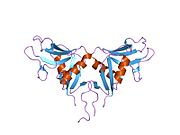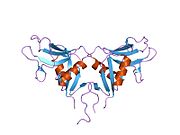OLR1
| OLR1 | |||||||||||||||||||||||||||||||||||||||||||||||||||
|---|---|---|---|---|---|---|---|---|---|---|---|---|---|---|---|---|---|---|---|---|---|---|---|---|---|---|---|---|---|---|---|---|---|---|---|---|---|---|---|---|---|---|---|---|---|---|---|---|---|---|---|
 | |||||||||||||||||||||||||||||||||||||||||||||||||||
| |||||||||||||||||||||||||||||||||||||||||||||||||||
| Identifiers | |||||||||||||||||||||||||||||||||||||||||||||||||||
| Aliases | OLR1, CLEC8A, LOX1, LOXIN, SCARE1, SLOX1, oxidized low density lipoprotein receptor 1 | ||||||||||||||||||||||||||||||||||||||||||||||||||
| External IDs | OMIM: 602601; MGI: 1261434; HomoloGene: 1910; GeneCards: OLR1; OMA:OLR1 - orthologs | ||||||||||||||||||||||||||||||||||||||||||||||||||
| |||||||||||||||||||||||||||||||||||||||||||||||||||
| |||||||||||||||||||||||||||||||||||||||||||||||||||
| |||||||||||||||||||||||||||||||||||||||||||||||||||
| |||||||||||||||||||||||||||||||||||||||||||||||||||
| |||||||||||||||||||||||||||||||||||||||||||||||||||
| Wikidata | |||||||||||||||||||||||||||||||||||||||||||||||||||
| |||||||||||||||||||||||||||||||||||||||||||||||||||
Oxidized low-density lipoprotein receptor 1 (Ox-LDL receptor 1) also known as lectin-type oxidized LDL receptor 1 (LOX-1) is a protein that in humans is encoded by the OLR1 gene.[5][6]
LOX-1 is the main receptor for oxidized LDL on endothelial cells, macrophages, smooth muscle cells,[7] and other cell types.[8] But minimally oxidized LDL is more readily recognized by the TLR4 receptor, and highly oxidized LDL is more readily recognized by the CD36 receptor.[9]
Function
LOX-1 is a receptor protein which belongs to the C-type lectin superfamily. Its gene is regulated through the cyclic AMP signaling pathway. The protein binds, internalizes and degrades oxidized low-density lipoprotein.
Normally, LOX-1 expression on endothelial cells is low, but tumor necrosis factor alpha, oxidized LDL, blood vessel sheer stress, and other atherosclerotic stimuli substantially increase LOX-1 expression.[8][10]
LOX-1 may be involved in the regulation of Fas-induced apoptosis. Oxidized LDL induces endothelial cell apoptosis through LOX-1 binding.[7] Other ligands for LOX-1 include oxidized high-density lipoprotein, advanced glycation end-products, platelets, and apoptotic cells.[7][10] The binding of platelets to LOX-1 causes a release of vasoconstrictive endothelin, which induces endothelial dysfunction.[10]
This protein may play a role as a scavenger receptor.[6]
Clinical significance
Binding of oxidized LDL to LOX-1 activates NF-κB, leading to monocyte adhesion to enthothelial cells (a pre-requisite for the macrophage foam cell formation of atherosclerosis).[8] Macrophage affinity for unmodified LDL particles is low, but is greatly increased when the LDL particles are oxidized.[11] LDL oxidation occurs in the sub-endothelial space, rather than in the circulation.[11] But oxidized cholesterol from foods cooked at high temperature can also be a source of oxysterols.[9]
Mutations of the OLR1 gene have been associated with atherosclerosis, risk of myocardial infarction, and may modify the risk of Alzheimer's disease.[6] When applied to human macrophage-derived foam cells in vitro, the dietary supplement berberine inhibits the expression of the ORL1 gene in response to oxidized low-density lipoprotein cholesterol,[12] but this has not yet been demonstrated in a living animal or human.
References
- ^ a b c GRCh38: Ensembl release 89: ENSG00000173391 – Ensembl, May 2017
- ^ a b c GRCm38: Ensembl release 89: ENSMUSG00000030162 – Ensembl, May 2017
- ^ "Human PubMed Reference:". National Center for Biotechnology Information, U.S. National Library of Medicine.
- ^ "Mouse PubMed Reference:". National Center for Biotechnology Information, U.S. National Library of Medicine.
- ^ Li X, Bouzyk MM, Wang X (Nov 1998). "Assignment of the human oxidized low-density lipoprotein receptor gene (OLR1) to chromosome 12p13.1→p12.3, and identification of a polymorphic CA-repeat marker in the OLR1 gene". Cytogenet Cell Genet. 82 (1–2): 34–6. doi:10.1159/000015059. PMID 9763655.
- ^ a b c "Entrez Gene: OLR1 oxidized low density lipoprotein (lectin-like) receptor 1".
- ^ a b c Pirillo A, Norata GD, Catapano AL (2013). "LOX-1, OxLDL, and atherosclerosis". Mediators of Inflammation. 2013: 152786. doi:10.1155/2013/152786. PMC 3723318. PMID 23935243.
{{cite journal}}: CS1 maint: unflagged free DOI (link) - ^ a b c Xu S, Ogura S, Chen J, Little PJ, Moss J, Liu P (2013). "LOX-1 in atherosclerosis: biological functions and pharmacological modifiers". Cellular and Molecular Life Sciences. 70 (16): 2859–2872. doi:10.1007/s00018-012-1194-z. PMC 4142049. PMID 23124189.
- ^ a b Zmysłowski A, Szterk A (2017). "Current knowledge on the mechanism of atherosclerosis and pro-atherosclerotic properties of oxysterols". Lipids in Health and Disease. 16 (1): 188. doi:10.1186/s12944-017-0579-2. PMC 5625595. PMID 28969682.
{{cite journal}}: CS1 maint: unflagged free DOI (link) - ^ a b c Kakutani M, Masaki T, Sawamura T (2000). "A platelet-endothelium interaction mediated by lectin-like oxidized low-density lipoprotein receptor-1". Proceedings of the National Academy of Sciences of the United States of America. 97 (1): 360–364. doi:10.1016/j.biochi.2016.10.010. PMC 26668. PMID 10618423.
- ^ a b Brites F, Martin M, Guillas I, Kontush A (2017). "Antioxidative activity of high-density lipoprotein (HDL): Mechanistic insights into potential clinical benefit". BBA Clinical. 8: 66–77. doi:10.1016/j.bbacli.2017.07.002. PMC 5597817. PMID 28936395.
- ^ Guan S, Wang B, Li W, Guan J, Fang X (2010). "Effects of berberine on expression of LOX-1 and SR-BI in human macrophage-derived foam cells induced by ox-LDL". Am J Chin Med. 38 (6): 1161–9. doi:10.1142/s0192415x10008548. PMID 21061468.










